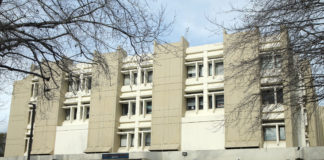Again! The long-time residents of Pajaro stand in the mud, their voices filled with frustration and anger. Some remember back to the March day in 1995 when they heard the assurances from politicians. Be patient! Help is coming! We’ve got your back!
The rampant cynicism is understandable. Today’s promises are almost word-for-word the same as those in 1995. And distrust of government is loose on the land.
For this historian who has gone back a century and more, the cynicism runs even deeper—it’s always been this way. The community of Pajaro has always been people of color, the first to go under, the last to recover.
Well, Virginia, I am here to relate some hope and optimism I discovered in the damp pages of the past.
To summarize previous columns: It all goes back to General Mariano Vallejo’s committee in 1850 drawing the boundary between Santa Cruz and Monterey County down the middle of the Pajaro River.
That decision forever required any attempt to connect the two sides to have the cooperation of both counties and ultimately, after 1868 the city of Watsonville.
Monterey County’s general inattention to its far-flung northern boundary is understandable given the county’s enormous size and the distance from the county seat.
The dynamic of ethnicity sharpened in 1888 when Watsonville’s Chinese community agreed to move from downtown to a site across the river. The Chinese and later farm labor residents of that other-side-of-the river community became critical in Watsonville’s economic prosperity. Still are.
The first decade—1888-1898—witnessed the transformation of the valley’s agriculture from wheat to diversified crops all dependent on folks to do the work in the fields.
Brooklyn Chinatown was owned by the John T. Porter family, a relationship that went beyond that of typical landlord-tenant. Mrs. Porter (Fanny) respected and cared for the Chinese residents and when anti-Chinese Federal legislation passed, the Exclusion Act of 1882, the Chinatown began to shrink.
Their places in the fields were taken by immigrants from Japan (who would see their own immigration stopped in 1924), the Philippines, the Dust Bowl, and eventually Mexico.
The Porters were mindful of the regular flooding and built two-story structures for their Chinese tenants—they moved themselves and their belongings upstairs until the waters receded.
Flooding was not the major threat for Brooklyn, but, like all of the regional Chinatowns, fire was.
One of the region’s major Chinatown fires came in May 1906 when the long-time fishing village at Point Alones in Pacific Grove burned almost entirely to the ground.
The startling contrast for that fishing village story and Brooklyn’s is that crowds of Pacific Grove citizens cheered the fire and looted the belongings of the Chinese both during and after the fire.
Compare that with the first major Brooklyn fire in 1924 which consumed the eastern half of the village. The Watsonville Fire Department stopped it from spreading, and even before the smoke cleared, Watsonville residents began pouring aid to their afflicted neighbors across the river. The Watsonville Chamber of Commerce sent blankets and food, and the Japanese Association sent cash, while the Red Cross went over to assist.
A second fire in March 1933 destroyed what was left, and again Watsonville sent help, but Brooklyn Chinatown was gone. The Porter family then surveyed, realigned the streets, subdivided the property and sold the lots.
The 45-year Brooklyn era not only set the pattern of farm labor on the south side of the river, but also the theme of compassion that the people of Watsonville had towards them.
The efforts to build a levee that would protect both sides of the river accelerated in the late 1930s with the formation of a flood protection association supported by affected property owners. It was not until the late 1940s that the federal gunmen were involved and a successful levee was built.
That levee was sorely tested by the huge Christmastime Flood, Dec. 22-24, 1955. That flood tore through downtown Santa Cruz, but the Pajaro River levee held. Barely.
In March 1995 the levee broke—nicknamed the “Blue Barrel Flood” because of the Smucker’s barrels that floated all over the valley. Again, as before, the people of Watsonville came out to help those in Pajaro and the politicians came to make promises.
So, what’s the problem? There is an impossible thicket of federal, state and local agencies, not counting the city of Watsonville and the two counties.
It will take a person of transcendent political acumen and courage to undo, for only this one issue.
I’m putting my money on two people: 1. State Senator John Laird, because he engineered the creation of the river-spanning Pajaro Valley Healthcare District enabling the rescue of Watsonville Community Hospital, and Monterey County Supervisor Luis Alejo, who has the unique experience of being a Watsonville city councilman before moving to Monterey County and being elected to its Board of Supervisors. Supervisor Alejo has a unique experience and understanding of both sides of the Pajaro Valley. Maybe this time!
Until then the Army Corps of Engineers is coming!
Can you hear them?
Meanwhile, at mud-level, the century-old legacy of care and compassion for the people across-the-river is being fulfilled by the two county Community Foundations and Cabrillo College Foundation is helping its Pajaro students. Ask Google to find them for you.
Then suppress your cynicism and send them what you can. We’ll bridge that river while the politicians are unable.
Sandy Lydon taught Asian, Asian-American, regional and local history at Cabrillo College from 1968 to 2022. He is an award-winning author and lecturer who will resume doing so publicly.













Sandy, thank you for the history lesson that we all should be made aware of.
As always I enjoy reading and hearing Sandy Lydon’s history lessons. I might add that another agency serving both Watsonville and Pajaro is the Pajaro Valley Unified School District. Construction of Oholone School serving K-5 Pajaro students was the first new school in the entire district since unification. It was long overdue. Hopefully the reconstruction of Pajaro Middle School flood damage will go fast and the students can then return to their school..